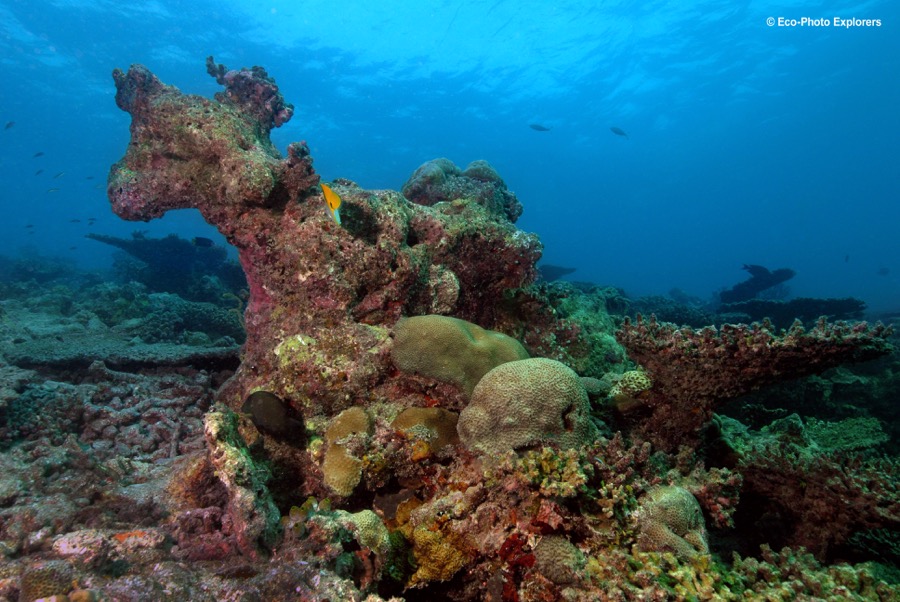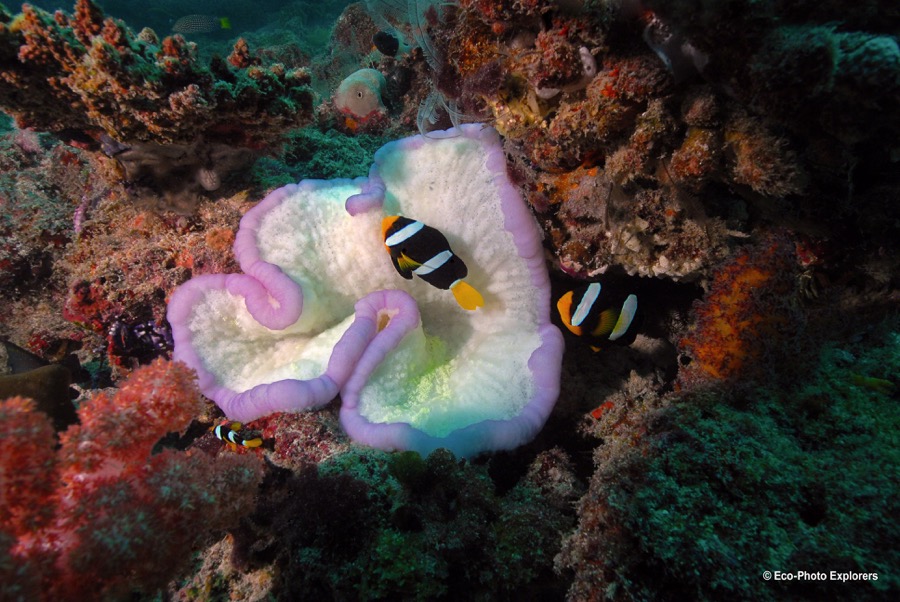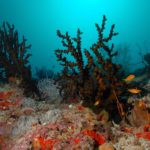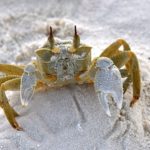Azure. Indigo. Turquoise. Aqua. Sapphire. Cobalt. There are seemingly innumerable shades of the color blue…and every single one of them seems to be on display in the Maldives! Standing on the deck of the Conte Max, the luxury Maldives liveaboard that was to be our home for the next week, we gazed out across a patch of the South Male Atoll and tried to count the different shades of blue we could see. We stopped at seven…not because we couldn’t count more colors but because the ship’s bell had rung, indicating it was time for the next dive briefing.
Story and photos by Michael Salvarezza and Christopher P. Weaver
From the air, the Maldive Islands appear very much like a set of small stones flung across a wide expanse of the Indian Ocean. Each of these tiny specks of sand are surrounded by a fringing coral reef, creating the idyllic postcard perfect tropical island vistas prized by the resorts that have been built on many of these islands. The islands themselves are part of the coral reef systems of the various atolls that comprise the Maldives, atolls that have become legendary in the world of diving: Ari, South Male, Felidhoo, Malaku and Baa to name just a few. While land based diving from the resort islands can be very rewarding, the best way to explore the vast ocean wilderness of the Maldives is by liveaboard dive vessel.
Shortly after our arrival into Male, we met the dive boat and began steaming south to the South Male Atoll. Our objective for this trip was an exploration of the central atolls of the Maldives. Within a few hours we pulled up to our first dive site, Velassaru Giri, a massive coral outcropping off Velassaru Island. This was to be our “checkout” dive.
We quickly climbed aboard the diving Dhoni, a dedicated dive tender used by the liveaboard to bring divers to and from the dive sites, and prepared for the dive. After a few minutes travel to the site and a giant stride entry we were on the reef.
Here, we were immediately impressed with clouds of Anthias darting in and out of the hard coral outcroppings of the site. We also noticed countless Redtooth Triggerfish alongside the coral wall, each of them daring to stray only inches from the safety of a crevice in the coral into which they would quickly hide upon our approach.
For a “checkout dive”, this was not bad!
Our dives at Velassaru Island included exciting drifts through the channels in the fringing reef and a dive on an unidentified sunken fishing vessel known as the Kuda Giri Wreck. This picturesque shipwreck lies perfectly upright alongside a coral dropoff, and is an ideal place to observe schools of brilliant red Soldierfish hiding within the wreckage. To reach this wreck, divers first descend along the coral wall and then make a short swim over the sand at about 80 FSW for about a hundred yards. In minutes, the ghostly bow of the vessel emerges from the blue and the wreck comes into view. Divers can swim along the deck, peering into the dark recesses of the cargo holds. For experienced wreck divers, it is very difficult to resist the temptation to venture inside! Once a fishing vessel dedicated to removing marine life from the sea, today the wreck is home to countless populations of marine life.
Divers exploring the Maldives must be prepared for strong tidal currents that flood in and out of the atolls. These currents can be disconcerting for unprepared divers, however they bring with them breathtaking action. At our next stop, Gulhi Island, we dove Miyaru Faru Corner, which is a bend in the coral formation marking the entrance to a channel. After a quick descent to the reef, we were swept up in the powerful current and immediately began flying over the reef. Our hearts raced as we passed over hard and soft coral colonies, and glimpsed briefly the brilliantly colored tentacles of sea anemones flapping in the tidal flow. These flyovers were nice, but our objective was the actual bend in the reef, where the big action of predators and prey was taking place. We were there in a few moments.

Schools of fish, like these Yellowspot Emperors (Gnathodentex aureolineatus), seek shelter in the reefs
Using reef hooks, we allowed ourselves to float in the water column like kites and watch excitedly as Grey Reef Sharks, Jacks, Tuna and Eagle Rays drifted by in the deep water. When it was time to move on, we simply detached our reef hooks and resumed our “flight” over the reef until we reached an area where the flow of water diminished and we were able to slow down and enjoy the shallow sections of the coral jungle.
Further south, we next visited the reefs alongside Alimatha Island in the Felidhoo Atoll. The memory cards in our cameras were quickly filled to capacity with scores of macro and wide-angle images. For example, we encountered Green Sea Turtles, schools of Oriental Sweetlips and massive clouds of Red Tailed Butterflyfish. But it was the tiny world of macro photography that really came to life here. As we peered underneath coral overhangs dripping with soft coral, we spotted many species of Angelfish and Butterflyfish, all of them featuring dazzling color designs like the bold yellow bands of the Royal Angelfish, or the mesmerizing line drawings of the juvenile Emperor Angelfish. Indeed, these fish can fairly be described as nature’s true works of psychedelic art.
Before the Conte Max left this island for its final island destination at Guraidhoo Island, we made a unique night dive at the Alimatha Jetty. Here, as local fisherman clean their fish and discard bits of fish into the water, dozens of Nurse Sharks, opportunistic Jacks and stealthy stingrays congregate for an easy meal. For divers, the action is spellbinding as the Sharks and Jacks patrol searching for food completely unaware of and uninterested in the voyeuristic divers. We remained fairly motionless on a sandy bottom in about 45 FSW and watched as 70-80 Nurse Sharks patrolled above, with countless Jacks slicing through the water column. An occasional stingray would lazily glide through the group of divers, scouring the sand for food. Although it is somewhat of an artificial dive because the marine life has been conditioned to look for food here, it is still an exciting dive and one that produces smiles of satisfaction every time.
Fierce currents and dizzying arrays of marine life characterized our final dives at Guraidhoo Island.
At a dive site known as Kandooma Beyru, we descended along a dramatic vertical wall to about 120 FSW and then began a brisk drift along the reef, stopping periodically to explore cuts in the wall where we could get out of the current and search for marine life and photographic subjects. Its an interesting sensation to duck into these natural shelters and then turn to peer back out into the blue, watching divers and the occasional jack or trevally glide by in the current.
Story and photos by Michael Salvarezza and Christopher P. Weaver
Macro photography is a challenge in fast moving water, but careful examination of whip corals and gorgonians revealed the presence of tiny gobies, each perfectly camouflaged to blend in to the host coral they inhabit. But stopping in the flowing water, maintaining neutral buoyancy, and focusing the camera on these tiny subjects while the whip coral or gorgonian they are perched on is flapping in the watery breeze is no small feat!
It was here that we also found a rainbow of large anemones, each with their attendant anemonefish. Green, yellow, white, purple and even day-glo orange were some of the colors of these anemones, causing us to begin referring to the Maldives as the Rainbow Reef!
While many of our dives would begin in deeper water, often the true circus of marine life could be found in the shallows atop the coral heads. Clouds of Yellow Sweepers, Blue and Gold Fusilers, and many schools of snapper and grunt, along with a wide array of reef fish in eye-popping colors, kept us endlessly entertained. On one dive, an army of Convict Surgeonfish rolled over the reef feeding on algae and other detritus in unison while on other dives we encountered Napoleon Wrasse, Titan Triggerfish and the uniquely patterned Clown Triggerfish in the shallows. Indeed, there really is no reason to go very deep in the Maldives because much of the interesting life of these reefs can be found in 40 FSW or less.
Pulling anchor and heading back to Male after a week of spectacular diving, we faced into a freshening wind and watched as Flying Fish took to the air ahead of the boat while dolphins cavorted in the distance. The northern monsoon was upon us and dark clouds hinted at troublesome weather to come. But despite the choppy seas between the atolls, and the growing wind and rain, the Conte Max remained a comfortable home on the Indian Ocean. Indeed, there is no better way to become immersed in the ocean world of the Maldives than to experience it from a liveaboard dive vessel, free to roam from atoll to atoll and to discover the wonders that lie beneath the waves in the Maldive’s coral jungle.
Getting There
The only international airport is located on the main island of Male. It is serviced with direct flights from Doha, Dubai, Colombo (Sri Lanka) and a few other destinations.
Visitors to the resort islands will next board speedboats or seaplanes depending on the location and distance of the resort. Check with your resort for arrangements. Many of the upscale resorts have comfortable lounges at the main airport where visitors can relax while waiting for transfers. Tours of Male can be arranged if the transfer time is longer than a few hours in duration.
Liveaboard dive boats, such as the Conte Max and the Duke of York, will arrange pickup right at the docks alongside the airport.
A valid passport is required for entry. Visas are not required.
Baggage
Baggage allowances vary for each international carrier so check before you leave. There are strict weight limits on the seaplanes so check with your carriers before departing.
Weather
The Maldives has an equatorial tropical climate. December through April is the dry season. February through April is the hottest time of the year, with temperatures in the 80s and 90s Fahrenheit each day. May through November is the rainy season.
Currency
The local currency is the rufiya (Rf) but US Dollars and Euros are generally accepted at all resorts.
Electricity
Power voltage used in the Maldives is 220 Volts to 240 Volts (50 Hz). Be sure to double-check your appliance’s compatibility before plugging them in. Converters / adaptors are usually available upon request at your hotel front desk.
Customs
The Republic of the Maldives is a strict Islamic nation. Alcohol, firearms, pornography, pork, narcotics and “idols of worship” are among the prohibited items.
Because of the concern over evangelists spreading their beliefs within the country, attention is paid to religious items. A small crucifix, worn as jewelry, is unlikely to be a problem but a suitcase with several Bibles will likely create concern!
Conte Max and Duke of York Liveaboard Dive Vessels
For more information on the Conte Max and Duke of York dive vessels: http://www.luxuryyachtmaldives.com/about.php
- The outer atoll walls are covered with dazzling marine life
- A pair of Clark’s Anemonefish (Amphiprion clarkii)
- The unfortunately named Varicose Wart Slug (Phyllidia varicose)
- The Maldives Anemonefish (Amphiprion nigripes) generally live in pairs or family groups
- The atolls are home to numerous species of hard corals
- The reefs of the Maldives support a wide variety of marine life
- Author Michael Salvarezza and some new found friends
- Predators like this Blacktip Grouper often lie in wait for their prey (Epinephelus fasciatus)
- A delicately colored Leaf Fish (Taenianotus triacanthus) belies its role as an ambush predator
- Soft corals come into full bloom at night
- Author and photographer Chris Weaver
- Author and photographer Mike Salvarezza
- A strikingly colored starfish from the Maldives
- Oriental Sweetlips (Plectorhinchus vittatus) are often seen in small groups or at cleaning stations
- Spiny Lobster (Panulirus penicillatus) peering out from a crevice
- Schools of fish, like these Yellowspot Emperors (Gnathodentex aureolineatus), seek shelter in the reefs
- Starfish can be found in many shapes, sizes and colors
- A school of Red-Tailed Butterflyfish (Chaetodon collare) scour the reef for food
- Spotted Moray Eel (Gymnothorax isingteena) pokes its head out from a crevice
- A Harlequin Sweetlips (Plectorhinchus chaetodontoides) at a cleaning station
- Sea fans adorn the walls of the atolls
- Starfish can be found in many shapes, sizes and colors
- Even uninhabited islands have been colonized!
- The Magnificent Partner Shrimp (Periclimenes magnificus) can often be found along the base of anemones.
- A pair of Clark’s Anemonefish (Amphiprion clarkii)
- The Maldives Anemonefish (Amphiprion nigripes) generally live in pairs or family groups.
Story and photos by Michael Salvarezza and Christopher P. Weaver
































